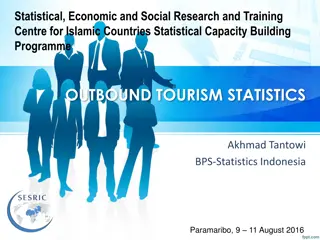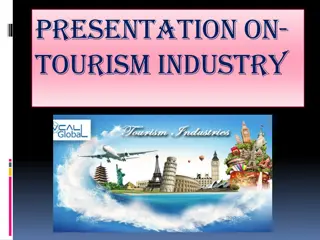Strategic Management in Tourism: Exploring New Business Trends
Explore the dynamic business environment and emerging trends in tourism through the SCEPTICAL framework of analysis. Delve into the key factors influencing tourism decision-making and shaping the future of the industry, encompassing social, cultural, economic, physical, technical, international, communication, infrastructure, administrative, and legal/political dimensions.
Download Presentation

Please find below an Image/Link to download the presentation.
The content on the website is provided AS IS for your information and personal use only. It may not be sold, licensed, or shared on other websites without obtaining consent from the author. Download presentation by click this link. If you encounter any issues during the download, it is possible that the publisher has removed the file from their server.
E N D
Presentation Transcript
3rd Edition Strategic Management In Tourism Edited by LUIZ MOUTINHO AND ALFONSO VARGAS S NCHEZ
CHAPTER 1 THE NEW BUSINESS ENVIRONMENT AND TRENDS IN TOURISM SHIRLEY RATE, LUIZ MOUTINHO AND RONNIE BALLANTYNE
LEARNING OBJECTIVES To explore the new business environment and trends in tourism using the SCEPTICAL framework of analysis. To examine the implications of key environmental trends on tourism business decision making. To consider how the emerging tourism trends will shape the future of the tourist sector.
1 THE NEW BUSINESS ENVIRONMENT AND TRENDS IN TOURISM The special relationship between the tourism industry and its marketing environment means that the depth of understanding needed concerning the influence of the environment goes far beyond that which suffices for many other industries. The external environment of any industry contains a myriad of interdependent factors which need to be somehow separated out and categorized to make analysis of them possible.
2 SCEPTICAL ANALYSIS IN TOURISM This framework provides a robust structure for understanding the complex business environment in which tourism providers operate. Each of these categories may be the source of change which present tourism operators with significant opportunities and threats. The challenge is in deciding what to do in the face of a changing and uncertain environment.
3 SCEPTICAL FRAMEWORK S SOCIAL FACTORS C CULTURAL FACTORS E ECONOMIC FACTORS P PHYSICAL FACTORS T TECHNICAL FACTORS I INTERNATIONAL FACTORS C COMMUNICATION AND INFRASTRUCTURE FACTORS A ADMINISTRATIVE AND INSTITUTIONAL FACTORS L LEGAL AND POLITICAL FACTORS
4 SOCIAL FACTORS Tourism is a social phenomenon and it is influenced by the society in which it exists. Tourism involves a large-scale, if temporary, transfer of individuals between different societies. This can create social change of both a temporary and a longer-term nature. Key trends which should be accounted for in tourism planning include: Demographic change. The democratization of tourism. Global urbanization.
5 CULTURAL FACTORS In tourism, there is a strong trend leading away from standardization towards diversity in lifestyles inciting new approaches to life and recreation and the rise of customization in tourist product offerings. Key trends which should be accounted for in tourism planning include: Increasing desire to relate to nature, to gain first- hand experience. Higher levels of environmental consciousness and altruistic tendencies. Increasing effort to learn about cultures.
6 ECONOMIC FACTORS Tourism as an industry can and does have significant impacts on an economy s growth. For governments, foreign exchange earnings, income and employment generation are the key drivers of economic growth which influence and encourage investment in the industry. However, the growth of the industry is reliant on a number of factors: Global economic conditions. Demand and supply.
7 PHYSICAL FACTORS A growing awareness of environmental factors and sustainability will continue to increase and intensify. Over time this will become a dominant factor in terms of influencing consumer decision making and ultimate consumer choice. Key trends which should be accounted for in tourism planning include: Growth of ecological tourism . Increase in the number of protected environments. Increase in ecological and sustainable planning.
8 TECHNICAL FACTORS Technological developments are changing the way that tourism providers are interacting with customers and are indeed altering the intrinsic make-up of the tourism product. Key trends which should be accounted for in tourism planning include: Rise of the prosumer . Individualization and specialization of tourist products. Increase in virtual tourism communities. Consolidation of tourism organizations.
9 INTERNATIONAL FACTORS The tourism industry s evolution has largely been dictated by developments in international travel and transport. The developments and changes in relations between countries should form a critical aspect of continuous environmental scanning for those in the tourism industry. Key trends which should be accounted for in tourism planning include: International relations impacted by terrorist activities. Political change removing barriers to movement.
10 COMMUNICATION AND INFRASTRUCTURE FACTORS Tourism providers are dependent on an existing infrastructure to handle travel, hospitality and communication. Although tourism is viewed as an intangible service business, the investment in infrastructure needed to support many tourism products would dwarf the capital expenditure of all but the most global manufacturers. Key trends which should be accounted for in tourism planning include: Transport. Accommodation. Facilities/Attractions.
11 ADMINISTRATIVE AND INSTITUTIONAL FACTORS For any form of business the environment will contain a wide range of institutions which can influence the operation and development of their business. Key institutions which should be accounted for in tourism planning include: Local government. National tourism organizations. Consumer groups. Special interest groups. Law enforcement agencies.
12 LEGAL AND POLITICAL FACTORS The nature and development of tourism in any country are largely the result of its government s ideology on this facet of economic activity. Governments control growth and development through investment, infrastructure and regulation. Key trends which should be accounted for in tourism planning include: Changes to subsidies and regulations. Government attitudes to tourism. Political instability.























